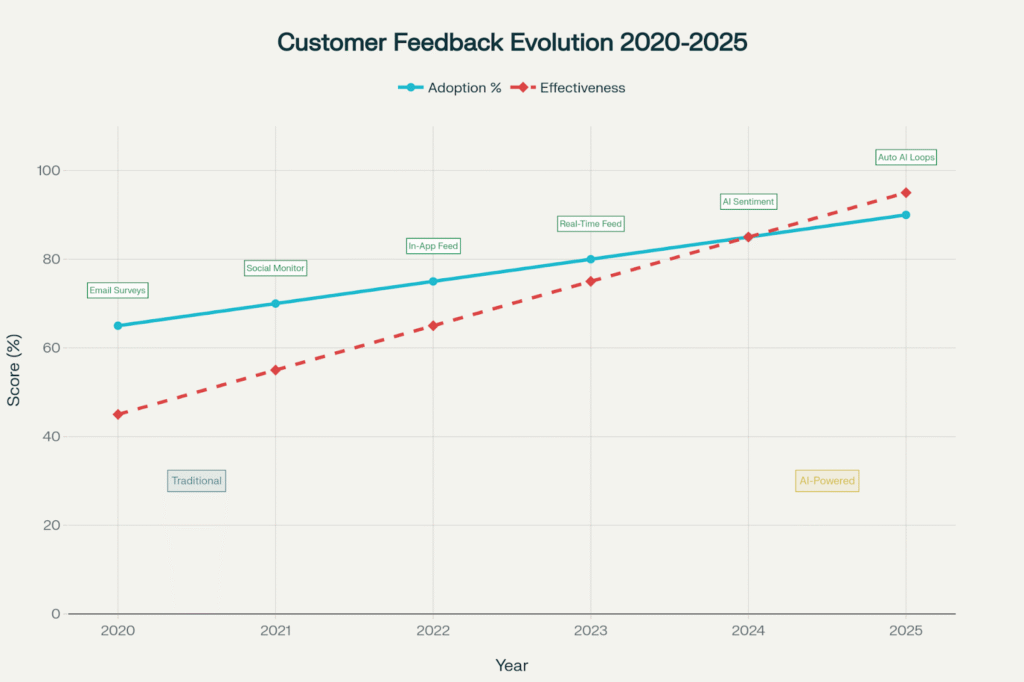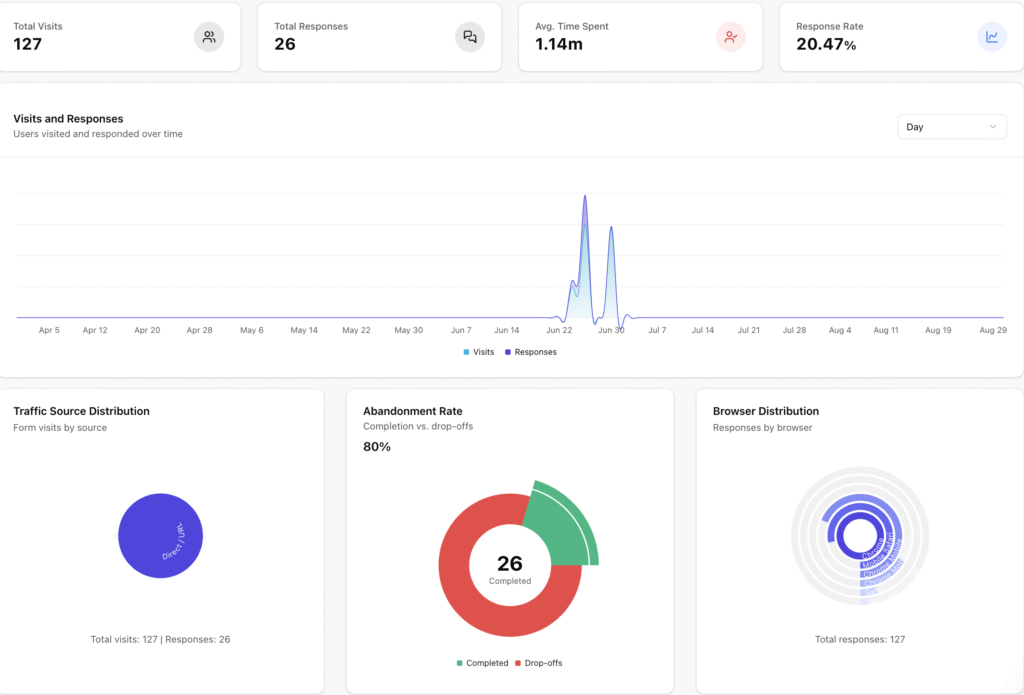Customer feedback collection has transformed dramatically, moving from traditional surveys to AI-powered, real-time insights that drive immediate business decisions. In 2025, businesses leveraging advanced feedback collection strategies are seeing 90% more accurate product decisions, while companies using AI in customer experience reduce churn by 10-15% and increase win rates by up to 30%. This comprehensive guide reveals the cutting-edge customer feedback collection techniques, tools, and strategies that industry leaders are using to stay ahead of the competition.

Evolution of Customer Feedback Collection Methods (2020-2025)
Understanding the Customer Feedback Revolution
Customer feedback collection in 2025 represents a fundamental shift from reactive data gathering to proactive intelligence systems. Modern businesses are no longer satisfied with collecting feedback after the fact – they’re building comprehensive Voice of the Customer (VoC) programs that capture, analyze, and act on customer insights in real-time

Team analyzing customer relationship management (CRM) data to gain insights and improve customer feedback strategies
The transformation is driven by several key factors: 80% of executive leaders now value customer experience as the new competitive battleground, while 67% of consumers worldwide have engaged with a chatbot for customer support in the past year. This shift toward automated, intelligent feedback systems represents more than just technological advancement – it’s a strategic necessity for businesses that want to thrive in an increasingly customer-centric marketplace.
The Modern Customer Feedback Ecosystem
Today’s customer feedback ecosystem is characterized by omnichannel collection methods that capture insights across multiple touchpoints simultaneously. Unlike traditional approaches that relied on post-interaction surveys, modern systems integrate feedback from social media mentions, in-app interactions, support conversations, and real-time behavioral data. This comprehensive approach ensures businesses capture the complete customer experience picture, not just isolated moments of satisfaction or dissatisfaction.
The integration of AI-powered sentiment analysis has revolutionized how businesses interpret feedback. Advanced natural language processing can now detect subtle emotions, intent, and context that basic sentiment analysis previously missed. This capability enables businesses to predict emerging issues before they escalate and identify opportunities for innovation based on customer sentiment patterns.
Real-Time Feedback Collection: The New Standard
Real-time customer feedback has evolved from a nice-to-have feature to an essential business capability. Businesses using real-time feedback are 33% more likely to retain customers, making it a critical component of customer retention strategies. Real-time collection captures customer sentiments at the exact moment of interaction, eliminating recall bias and providing more accurate, actionable insights.

The implementation of real-time feedback systems requires strategic placement of collection points throughout the customer journey. Event-based triggers ensure feedback requests appear at the most relevant moments – after a purchase completion, following a support interaction, or when specific product features are used. This contextual approach significantly improves response rates while gathering more meaningful insights.
Key Technologies Enabling Real-Time Collection
In-app surveys and embedded feedback tools represent the most effective methods for capturing immediate customer responses. These solutions integrate seamlessly into existing user interfaces, reducing friction while encouraging participation. Modern platforms like Feedal.io provide comprehensive real-time feedback solutions that automatically categorize and analyze responses using advanced AI algorithms.
Live chat and real-time conversations offer another powerful channel for immediate feedback collection. When integrated with intelligent routing systems, these interactions can trigger automated follow-up surveys or sentiment analysis, creating a continuous feedback loop that informs customer service improvements.
Multi-channel integration platforms consolidate feedback from various touchpoints into unified dashboards, providing businesses with comprehensive customer sentiment tracking. These systems can monitor feedback from websites, mobile apps, social media, and support channels simultaneously, ensuring no customer voice goes unheard.
AI-Powered Feedback Analysis and Automation
Artificial intelligence has fundamentally transformed customer feedback analysis, enabling businesses to process vast volumes of unstructured data and extract actionable insights automatically. By 2025, generative AI could handle up to 70% of customer interactions without human intervention, while AI-driven automation has led to a 30% decrease in customer service operational costs.

Advanced Sentiment Analysis and Theme Detection
Modern AI feedback systems go far beyond basic positive-negative sentiment classification. Semantic text analysis uses natural language processing to detect subtle tones, intent, and context behind customer responses, uncovering emotions like frustration, excitement, or hesitation that traditional analysis methods miss. This deeper understanding enables businesses to identify the root causes of customer satisfaction issues and opportunities for improvement.
Automated theme and entity detection processes feedback through sophisticated algorithms that identify recurring topics, pain points, and suggestions without requiring manual categorization. These systems can detect emerging trends in customer sentiment, allowing businesses to respond proactively to developing issues or capitalize on positive feedback momentum.
Predictive Analytics for Customer Experience
Predictive customer experience analytics represent the cutting edge of feedback analysis technology. These systems analyze historical feedback patterns, behavioral data, and sentiment trends to forecast future customer actions and satisfaction levels. Businesses can identify customers at risk of churning before they express dissatisfaction, enabling proactive retention efforts.
AI-driven prioritization helps customer service teams focus on the most impactful feedback by analyzing sentiment intensity, customer value, and business impact factors. This intelligent routing ensures critical issues receive immediate attention while routine feedback is processed efficiently through automated workflows.
Essential Customer Experience Metrics for 2025
Understanding which metrics to track and how to interpret them is crucial for building effective feedback collection systems. The three foundational metrics – Net Promoter Score (NPS), Customer Satisfaction Score (CSAT), and Customer Effort Score (CES) – each serve specific purposes in the customer experience measurement framework.
Net Promoter Score (NPS): Measuring Loyalty and Advocacy
NPS remains the most popular experience metric among B2B companies, measuring customer loyalty and likelihood to recommend your brand. The simple question “How likely are you to recommend us to a friend or colleague?” on a 0-10 scale provides powerful insights into customer advocacy potential.
Predictive NPS capabilities represent a significant advancement for 2025, using behavioral data and feedback patterns to identify customers likely to become detractors before they respond negatively to surveys. This proactive approach enables businesses to address issues before they impact customer relationships.
Customer Satisfaction Score (CSAT): Transaction-Specific Insights
CSAT surveys excel at measuring satisfaction with specific interactions or experiences. Unlike NPS, which captures overall relationship sentiment, CSAT provides actionable feedback about particular touchpoints in the customer journey. This granular approach makes CSAT particularly valuable for identifying operational improvements and service optimization opportunities.
Real-time CSAT collection immediately after interactions ensures businesses capture authentic reactions while experiences remain fresh in customers’ minds. Modern platforms integrate CSAT surveys directly into transaction completion flows, support ticket resolutions, and product usage workflows.
Customer Effort Score (CES): Measuring Experience Friction
CES focuses purely on transactional measurement, evaluating how much effort customers feel they had to exert to accomplish specific tasks. Research consistently shows that reducing customer effort strongly correlates with increased loyalty and positive word-of-mouth recommendations.
Integrated CES measurement works particularly well for evaluating customer service interactions, product usability, and process optimization initiatives. By consistently measuring and reducing customer effort, businesses create smoother experiences that encourage continued engagement and loyalty.
Advanced Feedback Collection Strategies
Modern feedback collection extends far beyond traditional survey methods to encompass sophisticated, multi-channel approaches that capture comprehensive customer insights. Omnichannel feedback collection ensures businesses gather customer voices from every interaction point, creating a complete picture of the customer experience.
Community-Driven Feedback and Social Listening
Online brand communities and social media groups provide authentic, unsolicited feedback that reveals genuine customer sentiments. 72% of consumers are more likely to stay loyal to brands that build strong online communities, making community engagement both a feedback collection strategy and a retention tool.
Advanced social listening platforms monitor discussions across forums, social networks, and review sites, automatically identifying brand mentions, sentiment trends, and emerging issues. These systems provide early warning indicators of potential problems while highlighting opportunities for positive engagement.
Automated Feedback Loops and Integration
Closed-loop feedback systems ensure that customer input leads to concrete actions and improvements. These systems automatically route feedback to appropriate teams, track resolution progress, and follow up with customers to confirm issue resolution. This systematic approach demonstrates genuine commitment to customer concerns while building trust and loyalty.
CRM and marketing automation integration enables sophisticated feedback triggered campaigns. When customers provide negative feedback, automated workflows can immediately alert customer success teams, trigger personalized outreach campaigns, or escalate issues to management attention. Positive feedback can automatically initiate referral programs or case study development processes.
Multi-Channel Feedback Aggregation
Comprehensive feedback management platforms consolidate input from surveys, social media, support tickets, reviews, and direct communications into unified analytics dashboards. This aggregation reveals patterns and trends that might be missed when analyzing individual channels in isolation.
Cross-channel sentiment correlation enables businesses to understand how customer experiences in one channel affect perceptions and behaviors in others. For example, poor support experiences might correlate with negative social media sentiment, while positive product experiences could drive increased referral activity.
Implementation Best Practices and Tools
Successful customer feedback collection requires strategic tool selection, proper implementation methodology, and ongoing optimization. The most effective approaches combine multiple collection methods with sophisticated analysis capabilities to create comprehensive customer intelligence systems.
Selecting the Right Feedback Platform
AI-powered feedback platforms offer the most comprehensive solutions for modern businesses. When evaluating platforms, consider automated analysis capabilities, multi-channel integration, real-time processing, and predictive analytics features. Leading solutions like feedal.io provide comprehensive AI-driven feedback analysis that automatically categorizes responses, identifies sentiment patterns, and generates actionable recommendations.
Integration capabilities represent another crucial selection criterion. Modern feedback platforms must seamlessly connect with existing CRM systems, marketing automation tools, support platforms, and business intelligence solutions. This integration ensures feedback insights inform decision-making across all business functions.
Creating Effective Survey Design and Distribution
Survey design optimization significantly impacts response rates and data quality. Best practices include keeping surveys concise, using clear language, mixing question types, and providing multiple response options. Mobile-optimized surveys are essential, as increasing numbers of customers provide feedback through smartphone and tablet interfaces.
Trigger-based survey distribution ensures feedback requests appear at optimal moments in the customer journey. Rather than sending generic periodic surveys, intelligent systems present feedback opportunities immediately after relevant interactions, purchases, or support resolutions.
Building Actionable Reporting and Analytics
Real-time analytics dashboards enable immediate response to customer feedback trends and emerging issues. Effective dashboards combine quantitative metrics with qualitative insights, providing both high-level performance indicators and detailed customer sentiment analysis.
Automated alert systems notify relevant team members when feedback indicates urgent issues or exceptional positive experiences. These alerts enable rapid response to customer concerns while facilitating proactive customer success initiatives.
Measuring Success and ROI
Demonstrating the business value of customer feedback initiatives requires comprehensive measurement frameworks that connect feedback activities to concrete business outcomes. Modern measurement approaches go beyond traditional satisfaction scores to encompass customer lifetime value, retention rates, referral generation, and revenue impact.
Key Performance Indicators for Feedback Programs
Feedback collection metrics provide baseline measurements of program effectiveness. Essential KPIs include response rates, feedback volume trends, channel effectiveness, and completion rates across different survey types and distribution methods.
Analysis and action metrics measure how effectively businesses convert feedback into improvements. Key indicators include average time from feedback to resolution, issue resolution rates, and the percentage of feedback that generates specific business actions or improvements.
Business Impact Measurement
Customer retention correlation demonstrates how feedback initiatives contribute to customer loyalty and lifetime value. Businesses tracking these connections consistently find that proactive feedback collection and response correlate with reduced churn rates and increased customer satisfaction scores.
Revenue impact analysis connects feedback improvements to financial outcomes through metrics like increased average order values, improved conversion rates, and enhanced referral generation. These measurements provide clear ROI justification for continued investment in feedback collection and analysis capabilities.
Future Trends and Emerging Technologies
The customer feedback landscape continues evolving rapidly, with several emerging trends shaping the future of customer experience measurement and management. Understanding these developments helps businesses prepare for continued evolution in customer expectations and technological capabilities.
Generative AI and Conversational Feedback
Generative AI chatbots and conversational interfaces are transforming how businesses collect and respond to customer feedback. These systems can conduct natural, contextual conversations that feel more personal than traditional surveys while gathering more detailed insights about customer needs and preferences.
Automated response generation enables immediate, personalized acknowledgment of customer feedback, demonstrating responsiveness while gathering additional context through follow-up questions. This approach significantly improves customer satisfaction with the feedback process itself.
Predictive Experience Analytics
Behavioral prediction models analyze customer interaction patterns, feedback history, and engagement data to forecast future satisfaction levels and potential issues. These systems enable truly proactive customer experience management by identifying intervention opportunities before problems manifest.
Intent-based optimization moves beyond keyword matching to understand the underlying motivations and goals driving customer feedback. This deeper comprehension enables more targeted improvements and personalized response strategies.
Getting Started with Modern Feedback Collection
Implementing effective customer feedback collection requires systematic planning, appropriate tool selection, and commitment to continuous improvement. Organizations beginning this journey should focus on establishing clear objectives, selecting appropriate technologies, and building processes that ensure feedback translates into meaningful improvements.
Begin by identifying critical touchpoints throughout your customer journey where feedback collection would provide the most valuable insights. These typically include post-purchase experiences, support interactions, product usage milestones, and service completion points.
Start with a comprehensive platform like Feedal.io that provides AI-powered analysis, real-time processing, and multi-channel integration capabilities. This foundation enables immediate sophisticated feedback collection while providing room for expansion as your program matures.
Establish clear response protocols that ensure customer feedback receives appropriate attention and follow-through. This includes automated acknowledgment systems, escalation procedures for urgent issues, and systematic tracking of improvement initiatives generated by customer input.
Conclusion
Customer feedback collection in 2025 represents a sophisticated, AI-driven discipline that goes far beyond traditional survey methods. Organizations that embrace comprehensive feedback strategies – combining real-time collection, advanced analytics, predictive insights, and systematic improvement processes – gain significant competitive advantages through enhanced customer relationships, reduced churn, and accelerated innovation.
The transformation from reactive feedback collection to proactive customer intelligence systems requires investment in appropriate technologies, strategic planning, and organizational commitment to customer-centricity. However, the returns – measured in customer lifetime value, retention rates, and business growth – justify this investment many times over.
Success in modern customer feedback collection depends on selecting the right combination of tools, implementing systematic collection and analysis processes, and maintaining consistent focus on translating insights into concrete improvements. Organizations that master these capabilities will thrive in the increasingly customer-centric business environment that defines competitive success in 2025 and beyond.
The future belongs to businesses that not only listen to their customers but also respond intelligently, quickly, and systematically to the insights they gather. By implementing the strategies and technologies outlined in this guide, your organization can build the customer feedback capabilities necessary for sustained growth and market leadership.
Let’s connect on a Demo call to better understand feedbacks